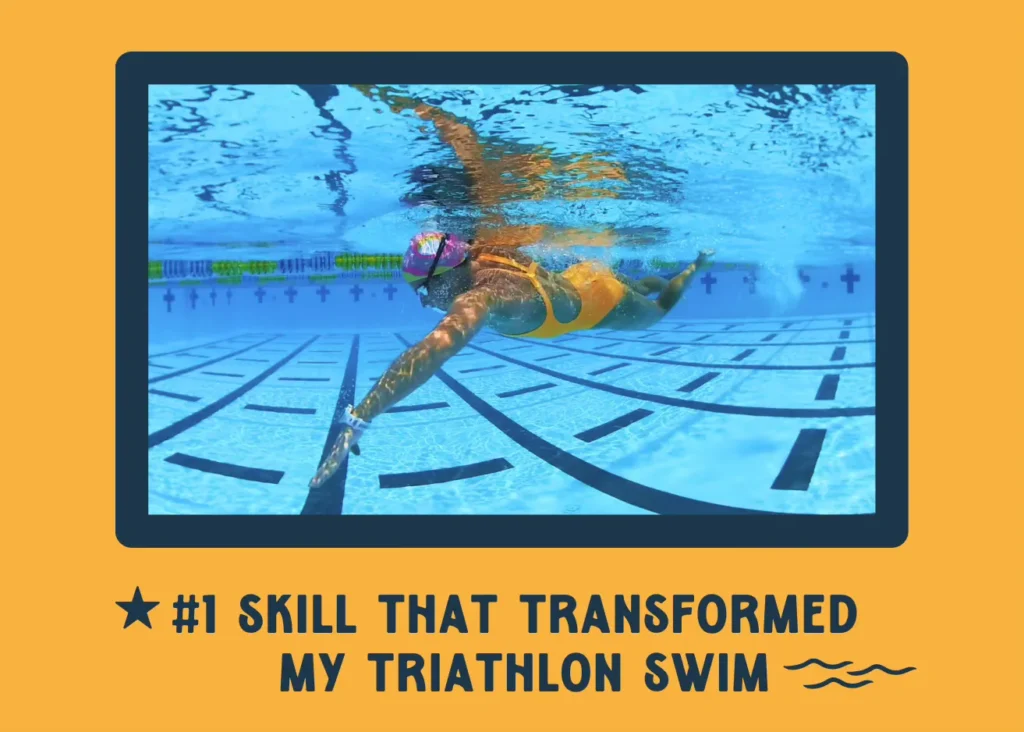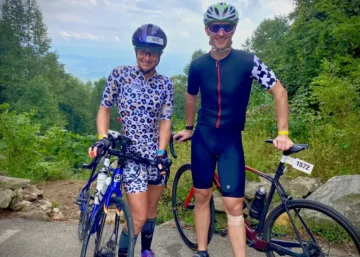
Ah, the triathlon swim. You either love to love it, or you love to hate it.
But either way, you’ve got to do it. Triathlon is swim-bike-run after all.
Unless it’s a duathlon, but nobody likes those. 😉
For most of us (myself included) we fall into the category of “adult-onset swimmers.” It’s just a fancy term that means you didn’t learn how to swim properly until you became an adult, and it still kind of freaks you out.
Growing up in Florida, I knew how to swim. My family was always on the boat. We went tubing and snorkeling. But swimming a proper freestyle?
That’s a whole different animal.
When I started training for my first triathlon, I met my coach at the pool for a swim lesson. I could swim from one end of the pool to the other (25 yards), and I was completely out of breath.
After some patient instruction, and a lot of practice, I progressed to 50 yards, which turned into 100 yards, 400 yards, 1,000 yards, and just last year I did my first 5K swim (3 miles in the ocean). Now, swimming is one of my favorite, and strongest, disciplines.
But it wasn’t always that way.
Like when I first started swimming, many people struggle with two key components of the triathlon swim: breath timing and pacing.
In my opinion, these two skills go hand in hand and are crucial for developing endurance, reducing anxiety, and setting yourself up for a successful triathlon.
Why is Swim Pacing Important in Triathlon?
Have you ever heard someone say this? “You can’t win the race in the swim, but you can lose the race in the swim.”
They’re talking about the importance of pacing.
It’s easy to make the mistake of thinking about each triathlon discipline in isolation. I can swim X, bike X, and run X, so I should finish the race in X amount of time.
But it’s important to recognize that triathlon is made up of three sports done in succession, so each discipline builds upon the next. When was the last time you did that in training?
Think of yourself like a phone battery. If the swim takes up 40% of your energy, and the bike takes up 50% of your energy, then what do you have left for the run? Only 10%… that’s not good.
In my opinion, the goal of the swim is to get from point A to point B in the least amount of time possible, while expending the least amount of effort. That’s why pacing matters, and breath timing helps with pacing!
Most Common Breathing Mistakes While Swimming
I’m not a coach, so I’m not going to teach you how to swim. But I can show you what I do that has helped transform my triathlon swim over the past 7 years.
If you combine the experiences of both my husband and I, we’ve been guilty of committing just about all of the most common breathing problems in the swim.
- Not exhaling fully under the water (Holding your breath means you can’t get a full inhalation of clean air).
- Exhaling too fast (Can lead to hyperventilation).
- Lifting your head up out of the water to breathe (Not efficient and causes your hips and legs to drop).
- Not breathing enough (Build up of CO2 makes you feel short of breath).
- Breathing too often (A short breathing interval can lead to hyperventilation).
Making any of these mistakes not only reduces efficiency in the swim, but can also contribute to the feeling of breathlessness, which causes anxiety.
Here are 4 cues I use to make sure I’m breathing properly during the swim.
- Make sure my head and neck are in a neutral position, not tilting up or down.
- Keep one goggle in and one goggle out of the water. I look at the underwater lane line for a visual cue.
- Initiate the turn to breathe when my opposite arm and shoulder pass by my ear during the recovery phase.
- Blow bubbles when my face is underwater.
The Importance of Bilateral Breathing
Triathletes have different styles of breathing when it comes to the timing and number of breaths they take while swimming.
Some swimmers only breathe to one side, while others breathe bilaterally, or to both sides. Some swimmers breathe every other stroke, while some swimmers breathe an odd number of strokes (like 3) so they can switch sides. Part of it is personal preference, but there are some best practices.
Swimming bilaterally is the best method, for a few reasons.
First, it prevents stroke imbalances that are caused by only breathing to one side in training. During a race, most of us will revert to our preferred side, and that’s ok, but using bilateral breathing during training is important.
You wouldn’t pedal your bike with only one leg, would you? What about running only in a circle to the left, all the time?
Second, think about the volume of swimming we do in training. Over time, breathing to just one side will create a weaker arm and a dominant arm. This can lead to injury.
Third, what happens if you’re in a race and waves are coming at you from your preferred side? Now, all of a sudden you’re stuck breathing to a side you aren’t comfortable with and that can cause anxiety.
Finally, form and technique are influenced by how and when we breathe. If you only breathe to one side, it can hinder your ability to rotate properly, which is what creates drive and propulsion for your stroke.
TIP: If you want to breathe to the same side, aka “even” (every 2 or 4 strokes) just be sure to switch sides often to prevent form imbalances.
Michael Phelps favored breathing every two strokes in practice, but he would switch sides every 25 yards. So he would breathe to the right on the way down to the wall and breathe to the left on the way back.
How I Combine Pacing with Different Types of Breathing
Our coaches give us a lot of pacing work in our swim workouts. We’re not swimming an entire 2,000-3,000 yard workout without stopping, and we’re not swimming random 100-400 yard intervals. They all have a specific intensity and very often a specific rest period.
For example, we might swim at sprint pace, Olympic pace, 70.3 pace, or Ironman pace.
Think of it like a run workout. You wouldn’t run 6 miles with no changes in speed or intensity, would you? During a run, you will likely have periods of high intensity followed by periods of lower intensity.
It’s the same thing with swimming.
My husband Matt often tells me that he has a hard time distinguishing between the different paces. Everything feels hard.
This is very common for new swimmers. I couldn’t distinguish paces at first either.
But after working to link up my breath timing with my pacing, I now know what it feels like to swim at five different paces, and I have a specific breathing style for each.
- Easy or Ironman pace
- 70.3 pace
- Olympic pace
- Sprint pace
- Pool sprint
Because I’ve practiced each breathing style so often, in correspondence with the appropriate effort level, once I start breathing that way my body knows how fast I should be swimming. In this way, pacing has become automatic.
- Easy or Ironman pace– (Bilateral breathing) I breathe every third stroke so I can switch sides (breathe, 1 stroke, 2 stroke, breathe on 3 stroke left side, 1 stroke, 2 stroke, breathe on 3 stroke right side, ect.)
- 70.3 pace– (Bilateral breathing) I use the same breathing pattern as easy pace, but there’s more a bit effort in my hip drive and pull.
- Olympic pace– (Breathe to one side) With the increase in effort level, I breathe to the same side every 2 strokes so (1 stroke, breathe on right side, 1 stroke, breathe on right side, ect.)
- Sprint pace– (Breathe to one side) The same breathing pattern as Olympic, but with a bit more gusto in hip drive and pull. I also add in a flutter kick.
- Pool sprint– (Breathe to one side) High intensity, reserved for doing 85%-90% intervals in the pool.
*I understand it might be a bit challenging to visualize this, but keep reading because I have video examples!
The key is that I practice each pace with the corresponding breathing pattern so I know what that effort level should feel like. This also serves as a feedback mechanism when I’m in a race.
For example, if I’m swimming in an Ironman or 70.3 and I can’t maintain bilateral breathing, that’s a sign I might be swimming too fast. In this case, I’m probably closer to my Olympic pace and I might want to back off a bit.
BONUS CONTENT for paid members: If you want to go a bit deeper into the conversation about breath timing and pacing in the triathlon swim, access video clip examples with explanation by clicking here.


